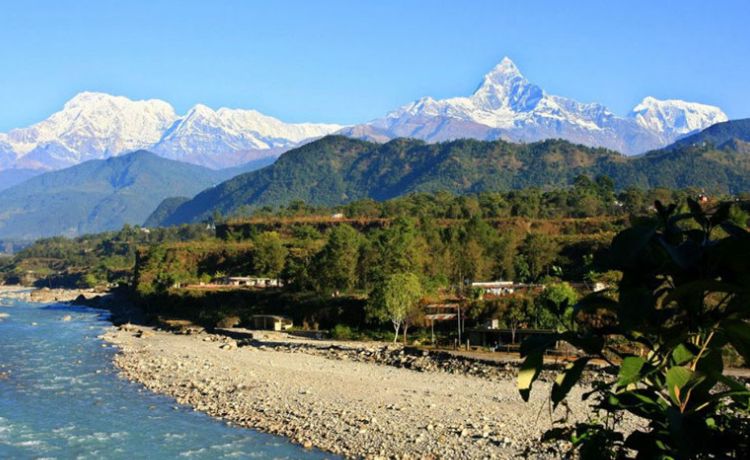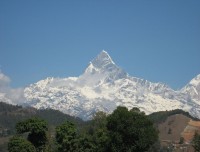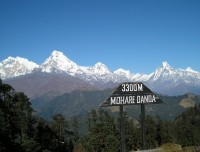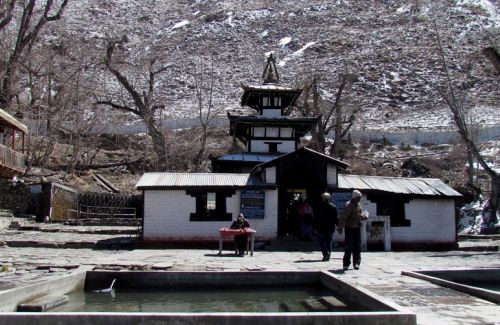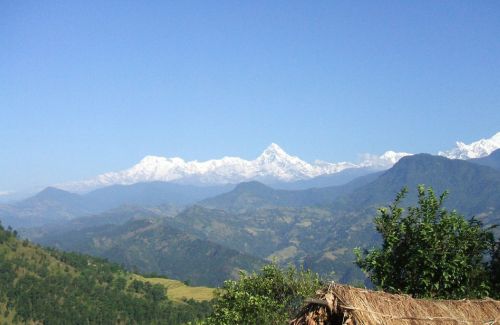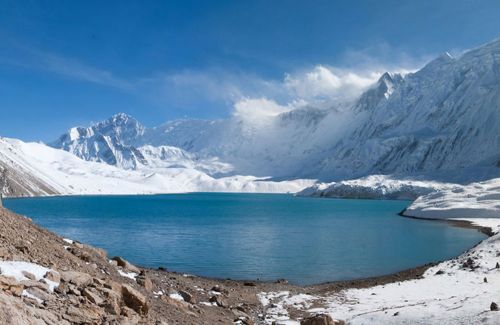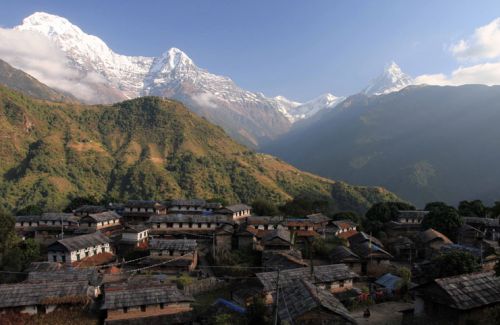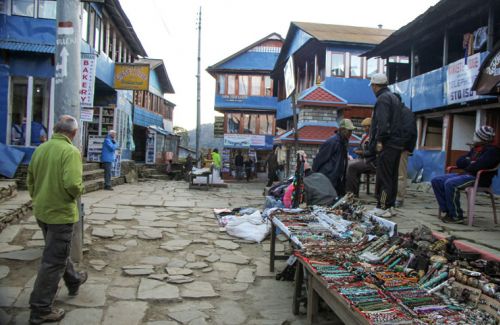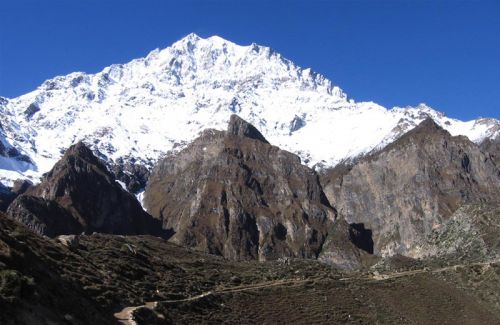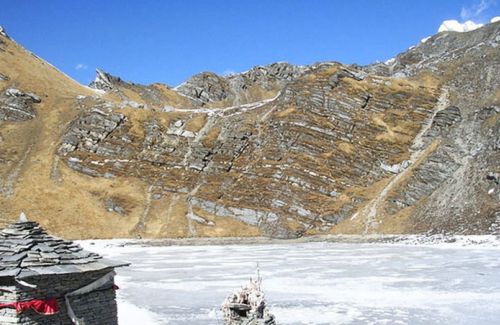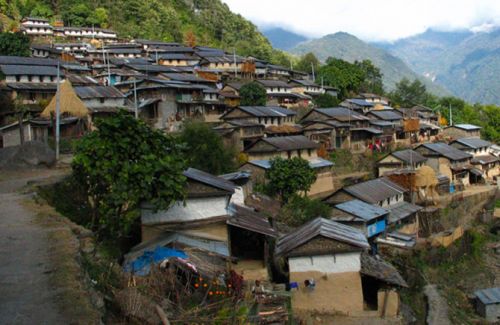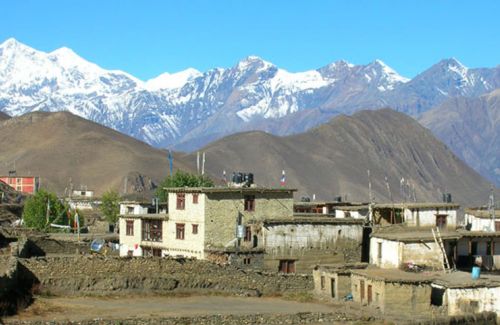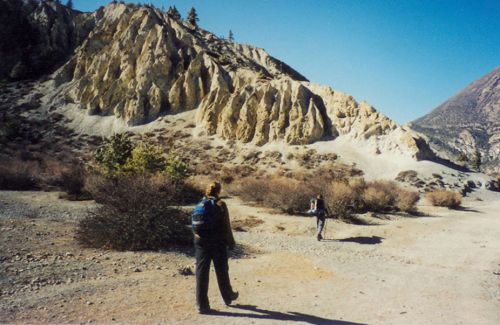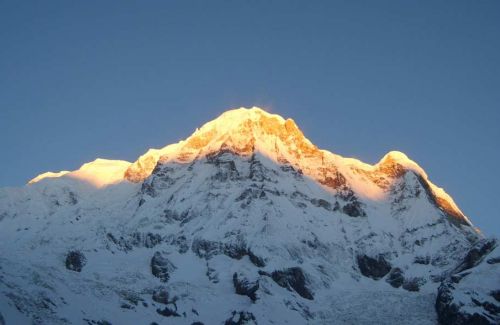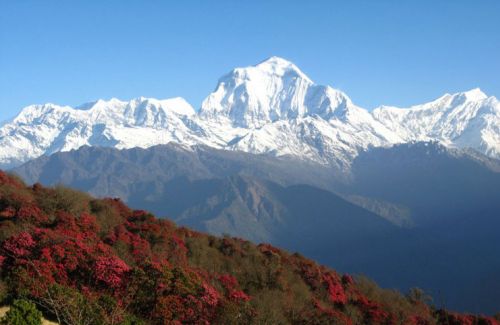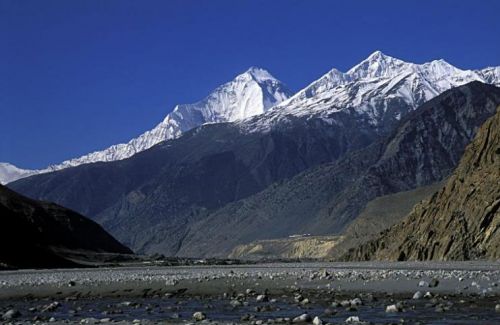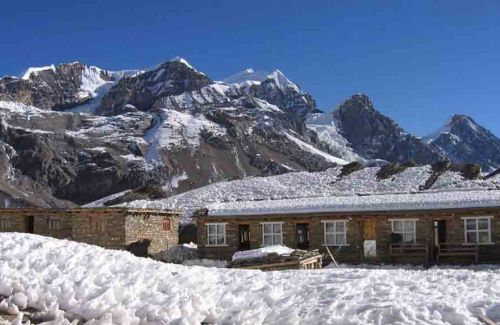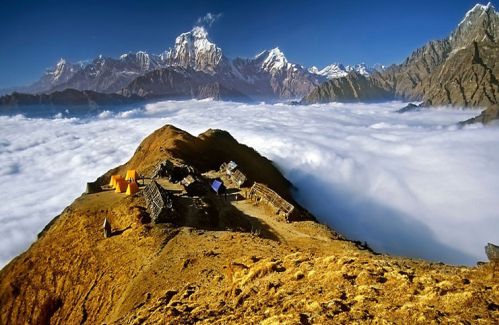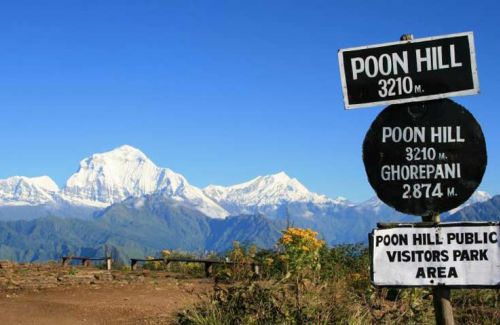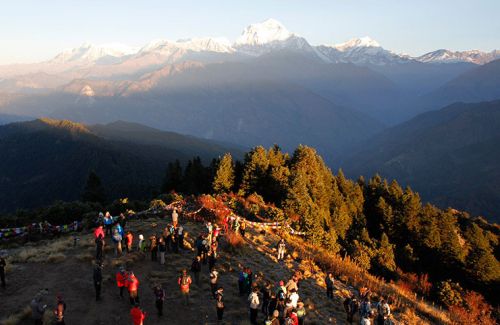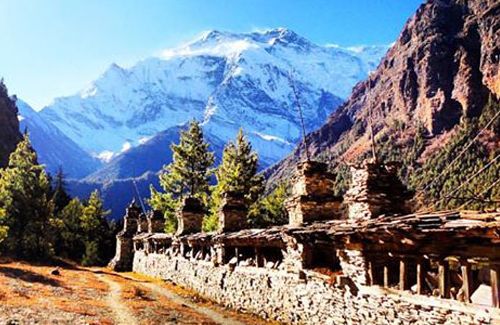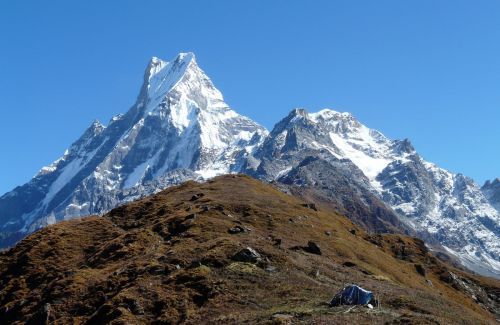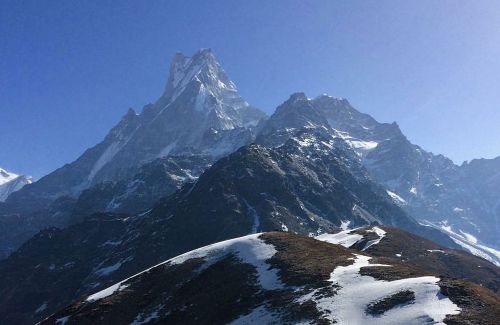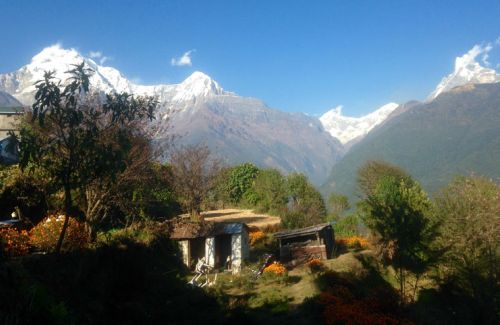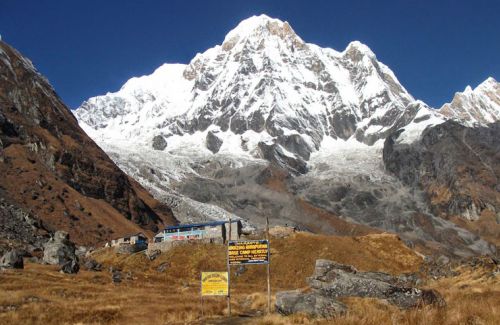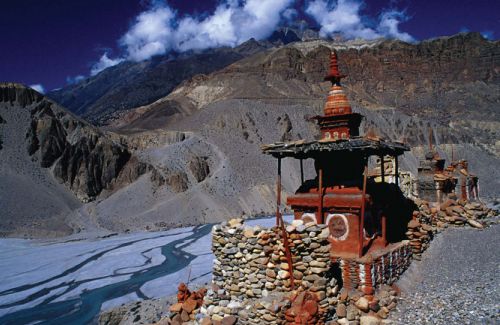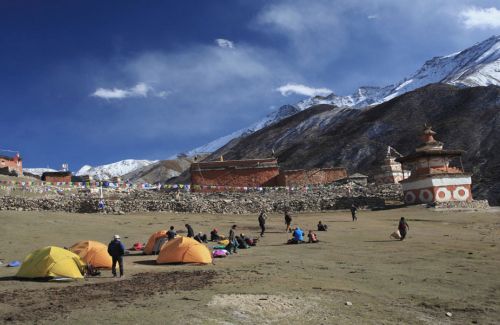Nagi Narchyang Trekking
- Duration18 Days
- Max. Altitude3,320 m
- Starts FromUSD 1350
Destination:Nepal
Trip Grade:Moderate (**)
Meals:Breakfast + Lunch + Dinner
Transportation:Private Vehicle / Aeroplane
Accommodation:Lodge
Trekking Region:Annapurna Region
Show All
Annapurna Region is considered one of the busiest trekking region due to its popularity due to series of Annapurna Massifs, unique culture, lifestyle, traditions and tempting landscapes since long but the trail is in risk, shortening day by day because of motorable roads. It is essentially necessary to identify, explore and promote an alternative trekking trails one after another. Trek Nagi - Narchyang, are new trails, expected to offer something new to the trekkers.
The Nagi Narchyang trekking begins from Galeshwar of Parbat District and passes through Nagi, Narchyang and Tatopani before ending at Beni of Myagdi. Nagi Narchyang Trek is community based trekking trail,developed as per the Eco- friendly concept. We can reach to Galeshwor after a short drive from Beni, the headquarter of Myagdi. The famous Galeshwor temple lies there which is the main attraction of this place. We can be at Banskharka village for the first night stay. There is an excellent home stay management. There are Magar people settlement and the village is famous for orange farming.
Nagi Village situated at an altitude of 2,300 m above sea level in Myagdi district. We reach to Nagi via Dandakateri of Parbat district. The village is widely known as “The Internet Village”. Mahabir Pun is the pioneer to contribute this remote village after he studied in U.S. and wireless Internet has been facilitated under his initiation. The community lodge with 10 rooms , has been built jointly by Local Community, UNDP/MEDEP, TAAN and NTB. This is the vantage point for the wonderful mountain views of Dhaulagiri I,II,III,IV and V, Gurja Peak, Annapurna South, Barah Himal , Nilgiri Himal and others. Nagi has possessed other attractions like Baraha Temple, Organic farming and hand- made paper production. Traditional Sorathi dance of Pun Magars is another magnetic thing for the trekkers.
We reach to Mohare Danda(3300 m) after Nagi and the best view point for the sun- rise and sun set. After a day long hike from Mohare Danda, we will be in Tikot. Tikot offers a magnificent view of Dhaulagiri. Khopra can be reached after a steep climb from Swant via Dandakharka. It offers the magnificent views of Andha Gorge, the deepest gorge in the world. Khopra village is the gateway to Barahi Tal (4600m.). Narchyang Village is the largest village situated at an altitude of 1200m. This village lies in Annapurna Conservation Area and is rich in terms of its bio- diversity. A hike less than two hours from Narchyang takes trekkers to Tatopani. Tatopani is the final destination of this trek. We reach to Beni after 3 hours drive from Tatopani. If anyone would like to go for other options, then can return to Pokhara or starting trek to Dhorpatan or Dhaulagiri Base Camp.
Trip Highlights
- Full day sightseeing in UNESCO World Heritage Sites in Kathmandu
- Scenic drive from Kathmandu to Galeshwor and from Pokhara to Kathmandu
- The best alternative trekking route in Annapurna Region
- The community based trail, developed in eco friendly concept
- Ethnic cultural diversities and their ways of living
- Visit famous Galeshwor Temple of Parbat district
- Dandakateri village,the wireless internet village
- The Magasaysay prize winner Mahabir Pun contributed village
- The best view point at Moharedanda
- Newly explored trekking route in Annapurna Region
- Eco-friendly community based accommodation
Day to Day Itinerary
Day 01:Arrival in Kathmandu Airport and Transfer to Hotel. Overnight at Hotel
Day 02:Pre-Trip Meeting and Full day Sightseeing in Kathmandu. O/N at Hotel
Day 03:Drive from Kathmandu to Galeshwor (1,170 m), 285 km, 8-9 hrs. O/N at Guest House
Day 04:Trek from Galeshwor to Banskharka (1,526 m), 5-6 hrs. O/N at Home Stay
Day 05:Trek from Banskharka to Nagi (2,320 m), 4-5 hrs. O/N at Community Lodge
Day 06:Trek from Nagi to MohareDanda (3,320 m), 4-5 hrs. O/N at Community Lodge
Day 07:Trek from Mohare Danda to Pyari Bahurani Tal (2,668 m), 5-6 hrs. O/N at Community Lodge
Day 08:Trek from Pyari Bahurani Tal to Tikot (2,250 m), 5-6 hrs. O/N at Community Lodge
Day 09:Trek from Tikot to Khibang (2,060,m), 5-6 hrs. O/N at Community Lodge
Day 10:Trek from Khibang to Swanta (2,270,m), 4-5 hrs. O/N at Community Lodge
Day 11:Trek from Swanta to Khopra (3,660 m), 5-6 hrs. O/N at Guest House
Day 12: Trek from Khopra to Narchyang (1,510 m), 4-5 hrs. O/N at Home Stay
Day 13:Trek from Narchyang to Tatopani (1,190 m), 4-5 hrs. O/N at Guest House
Day 14:Trek from Tatopani to Ghorepani (2,865,m), 5-6 hrs. O/N at Guest House
Day 15:Hike to Poonhill (3,210,m). Trek to Hile (1,100,m), 5-6 hrs. O/N at Guest House
Day 16:Trek from Hile to Nayapul (1,025,m),6 hrs, then drive to Pokhara (827 m). O/N at Hotel
Day 17:Drive from Pokhara to Kathmandu, 200 km, 6-7 hrs. O/N at Hotel
Day 18:Departure to International Airport
Cost Include
- Airport picks up and drops off by private tourist vehicle
- A government licensed holder city tour guide
- Three nights in Kathmandu and 1 night in Pokhara twin sharing 2-3 star hotel with Breakfast
- Guided city tour in Kathmandu by private tourist vehicle
- Drive from Kathmandu to Galeshwor and drive back from Pokhara to Kathmandu
- Full board meals (Breakfast + Lunch + Dinner) during the trek
- Lodges, Guesthouses accommodation during the trek
- Professional license holder English speaking Trekking Guide
- The required number of local staff and porters (2 Trekkers = 1 Porter)
- Food, accommodation, salary, insurance, equipment and medicine for all staff
- Langtang National Park Entry Permit and TIMS permit for trekking
- Down Jacket, Duffle bag and sleeping bag by Himkala Adventure if required
- Drive from Nayapul to Pokhara by vehicle
- Farewell Dinner in typical Nepalese restaurant with cultural show
-
Government taxes, VAT and Service charge
Cost Exclude
- Lunch and dinner in Kathmandu
- Entrance fee in all monuments during tour
- Emergency rescue and evacuation cost
- Your travel insurance
- Nepal entry visa fee
- Personal expenses like: phone bill, laundry, hot shower, hot and cold drinks etc
- Personal trekking equipment
- Tips for trekking, tour staff and driver (Tipping is expected)
- Any others expenses which are not mentioned on ‘Cost Includes' section
Detail Itinerary
Day 01Arrival in Kathmandu Airport and Transfer to Hotel. Overnight at HotelUpon your arrival at Tribhuvan International Airport, our representative from Himkala Adventure will heartily welcome you and transfer to the hotel. You could utilize the rest of the time taking rest so that you could feel no jet lag and we continue our tour and trek from the next day. Overnight stay at hotel
Day 02Pre-Trip Meeting and Full day Sightseeing in Kathmandu. O/N at Hotel After breakfast, around 9 am, we set out for the guided city tour to the UNESCO World Heritage sites where we will visit grandeur stupas, ornately decorated monasteries, maroon or yellow color dressed monks circumambulating clockwise chanting “Om Mani Padme Hum”, exquisite temples in different architectures and the different ethnic groups’ cultural activities. The craftsmanship from Malla period is captivating. After the sightseeing, we return back to hotel and do preparation for the trek to Nagi Narchyang that begins from the next day. There will be our experienced trekking guide, give us briefing about the trekking to newly explored areas. Overnight at hotel in Kathmandu
Day 03Drive from Kathmandu to Galeshwor (1,170 m), 285 km, 8-9 hrs. O/N at Guest House After breakfast, we drive from Kathmandu to Galeshwor which is 285 km west from Kathmandu. It takes about 7-8 hours. Galeshwor has its identity as a religious and cultural destination. Many pilgrims come to worship Galeshwor Mahadev with great devotion. Overnight at guest house
Day 04Trek from Galeshwor to Banskharka (1,526 m), 5-6 hrs. O/N at Home Stay After breakfast, we begin our trek and cross the Suspension bridge of Kali Gandaki River. We keep on continuing our trek passing through the panoramic landscape and typical Nepalese houses in the west region.We arrive at Banskharka which is mostly a Magar settlement. The village is famous for orange farming. Overnight at home stay
Day 05Trek from Banskharka to Nagi (2,320 m), 4-5 hrs. O/N at Community Lodge After having breakfast, we start out trek towards Nagi, the famous village, known as “Internet Village”. This is the old and unique cultural settlement of Magar community. Wireless Internet service started in the initiation of Ramon Magsaysay Award Winner Mahabir Pun is the main attraction of this village. From Nagi, we can view Dhaulagiri, Annapurna South, Nilgiri, Tukuche and Dhampus Pass. Local people produce organic food, export handmade paper. The Sorathi dance is very popular cultural dance shown in the evening. Overnight at community lodge
Day 06Trek from Nagi to MohareDanda (3,320 m), 4-5 hrs. O/N at Community Lodge After breakfast, we start hiking from Nagi through the dense forests of Pine and rhododendron forests. We can have fascinating mountain views on the way. Mohare Danda is the best view point for the sun rise and sun set. One can get the stunning mountain view of 28 peaks in the clear day from Annapurna and Gauri Shankar range. The community has operated a cross breeding project of yaks to generate income to finance their activities. Overnight at community lodge
Day 07Trek from Mohare Danda to Pyari Bahurani Tal (2,668 m), 5-6 hrs. O/N at Community Lodge The trail fluctuates from MohareDanda and goes through the beautiful rhododendron forest. The trail offers the astonishing Himalayan beauty of Dhaulagiri, Gurja Peak, Tukuche Peak and Chuchura Peak. Overnight at community lodge
Day 08Trek from Pyari Bahurani Tal to Tikot (2,250 m), 5-6 hrs. O/N at Community Lodge From here, we head towards Tikot. Tikot is also the village of Pun Magars. Tikot offers the great view of Dhaulagiri. There is also the community –run lodge to accommodate the trekkers. Overnight at community lodge
Day 09Trek from Tikot to Khibang (2,060,m), 5-6 hrs. O/N at Community Lodge We descend through the lovely forest of rhododendron and arrive at Khibang. Khibang is the beautiful village of around 800 Pun Magars. They produce 100% organic farm products. The village lies in the Annapurna Conservation Area. The place can provide wide knowledge about their life style, culture and their tradition. Overnight at community lodge
Day 10Trek from Khibang to Swanta (2,270,m), 4-5 hrs. O/N at Community Lodge After breakfast, we descend down through the Magar village. After crossing stream, we gradually ascend to the the beautiful village of Swanta. This is the village about 52 houses, lies in Annapurna Conservation Area too. This is another spot from where we can view Dhaulagiri, Gurja, Tukuche and Chuchura Peaks clearly. Overnight at community lodge
Day 11Trek from Swanta to Khopra (3,660 m), 5-6 hrs. O/N at Guest House After breakfast, we climb steep from Swanta via Dhandkharka. We pass through the cultivable land, dense forest and arrive at Khopra. Khopra is also the popular view point for the mountains in the western region to the far western region. It also offers the magnificent view of Andha gorge (The world’s deepest gorge) and Dana Valley. Khopra valey is the gateway to the Barahi Tal, situated at an altitude of 4,600 m. The place is worth visited in the time of ritual thread ceremony festival. Overnight at guest house
Day 12 Trek from Khopra to Narchyang (1,510 m), 4-5 hrs. O/N at Home Stay After breakfast, we descend down through the pasture land. The landscape and rich vegetation has studded this area. The houses made of stones and mud plaster are attached each other.There is also the dominant population of Magar community in Narchyang, about 2600 people. Overnight at home stay
Day 13Trek from Narchyang to Tatopani (1,190 m), 4-5 hrs. O/N at Guest House After breakfast, a hike less than two hours from Narchyang takes us to Tato pani. So, we descend down through the rough trail and explore the Kali Gandaki Valley. We can see the waterfall on the way. After crossing the Suspension bridge of Kali Gandaki River, we arrive at Tatopani (Hot Spring). This is the major attraction of natural hot water. Overnight at Guest House
Day 14Trek from Tatopani to Ghorepani (2,865,m), 5-6 hrs. O/N at Guest House After breakfast, we ascend from Tatopani to Ghorepani. It is about 6-7 hours trek via Chitre and Shikha. The trail offers amazing landscape with forest, sloppy landscape, waterfalls and the scene of local peoples’ activities. We finally arrive at Ghorepani and take rest. Overnight at lodge
Day 15Hike to Poonhill (3,210,m). Trek to Hile (1,100,m), 5-6 hrs. O/N at Guest House Early in the morning we hike about one and half an hour to the view point at Poon Hill. The the the best view point for the sun rise and sun set. We climb back to the lodge, get our breakfast and set out for the nest destination to Hile. We trek down to Hile which takes about 5 hours. We take our lunch at Banthanti on the way and arrive at Hile. Overnight at Guest House
Day 16Trek from Hile to Nayapul (1,025,m),6 hrs, then drive to Pokhara (827 m). O/N at Hotel After breakfast, we trek from Hile to Nayapul from where we drive to Pokhara. We can go for evening walk around the Phewa Lake and do boating. Overnight at hotel
Day 17Drive from Pokhara to Kathmandu, 200 km, 6-7 hrs. O/N at Hotel We can fly from Pokhara to Kathmandu in the morning. This is scenic flight of 30 minutes. We arrive at hotel in Kathmandu and spend the rest of time for taking rest. Overnight at hotel
Day 18Departure to International Airport We transfer you to International Airport 3 hours before your flight. So, if you have enough time left before you depart to International Airport, you could stroll around Thamel or go for some shopping to local market at Asan, Indrachowk. We finally depart you in the airport with gratitude that you joined Himkala Adventure for the trek to Nagi Narchyang. Have a great journey!
Trip FAQ
Himkala Adventure would like to quench the thirst of all necessary questions answers about Nagi Narchyang Trekking for all curious travelers/trekkers in the world. As you are entirely from different geographical location, you could better to know everything about the treks from the beginning i.e. airport pick up till your departure like airport picks up, drops off, accommodation in city, in the trek, guide and porters, safety for the trekking, food and accommodation and some other things that you might face on the way. Hope our endeavor listing these questions answers will help you self informed.
This is simply the outlines of the services we offer but it may differ as per your requirement, number of trekkers. What we go through our conversation, we will manage the means of transportation, hotels in the city, accommodation in the trekking, numbers of porters etc. This is general idea about Nagi Narchyang trekking before your trip and you become clearer about the trek. Please feel free to contact us to get more information about the trekking in the Himalayas of Nepal.
1) How is Nagi Narchyang Trekking in Nepal?
Nagi Narchyang Trekking is an alternativer trekking trail of Annapurna Region in the western part of Nepal.The newly explored trek reaches up to 3,320 m from the sea level. It is a moderate trek and can be done by anyone. The trail passes through beautiful villages, high passes and rugged landscape. It offers some of the best views of mountain peaks in Annapurna range. The region is also rich in terms of unique culture, tradition and lifestyle of people. The sunrise and sunset view from from Maharendra Lekh and sun set from Nagi and Khopra Lekh are astoundaing.
2) What physical fitness do I need to book this trip?
Every trekking in the Himalayas of Nepal require the certain level of physical and mental fitness.So, we advise you to be in good physical shape and able to feel comfortable while hiking up and down 7 to 12 miles per day on a trail carrying a day pack of about 10 pounds. Three things could make you confident enough for any trek you would like to do: aerobic, strength and mental.
Aerobic conditioning is important primarily because you will be trekking in thinner air, up to 40% less than at sea level. With good aerobic conditioning, you will be able to better metabolize whatever oxygen is available to you. You should plan on doing at least one hour of aerobic 3 /4 times per week for 1 month or more before your arrival in Nepal. Walking, jogging, cycling, hiking on valley floor to ridge line ascents with day back are some of the excellent forms of exercise, so long as you are strengthening leg muscles and building stamina. Speed is not the essence; stamina, confidence and continuity are.
3) How do I find Himkala Adventure for my pick up at the airport?
Our representative from Himkala Adventure will display a small board of company or your name on the sheet of paper outside the airport terminal. You will be driven to the hotel by our tourist vehicle.
4) What sort of accommodation do I get in Kathmandu and Pokhara ?
Normally we provide standard rooms with twin sharing accommodations at three star or similar category hotels in Kathmandu and Pokhara including breakfast. Accommodation in these cities can be upgraded as per your request. But some of our packages are sold without accommodation in the city.
5) How are tea house facilities during Nagi Narchyang Trekking?
Tea House is the combination of guest house, restaurant, and social hang out. Guest House, Home Stay and Eco-friendly Communit Lodges in Nagi Narchyang Trekking area are like our own home with great hospitality though they are simple but with neat and clean lodging offering fine views and plain but fresh and hygienic food with friendly atmosphere Most of the Tea Houses have running water facility. Many of them have hot water available for bathing. But we discourage our groups from using water heated by wood as lack of firewood in most villages is a big environmental concern in Nepal.
6) What sort of accommodation do I get in trekking?
Guesthouses/Home Stay and Eco-friendly Community Lodges provide twin sharing single and double rooms and occasionally a dormitory which is basically clean with a mattress and a quilt or blanket. Our company provides the sleeping bag if needed but we always recommend having your own sleeping equipments. You have to share the room with your group member or sometimes with unknown traveler. The toilet is always outside the room with basic facilities.
7) What sort of foods, water and drinks can I expect in trekking?
The foods in the Himalayas are very simple. There are mostly the family members themselves to cook and serve the meal. They are simply trained but experienced because they have been offering such services for many years in this busy route. The food is hygienic, fresh and delicious. We recommend you to drink mineral water or the boiled or using water purification pills or drops.
Most of the foods are cooked in the kitchen of tea houses. They serve you with different varieties of delicious Nepali and continental dishes. The most popular Nepali food is daal bhat (rice and lentils) with some mixed vegetable curry. Garlic soup is popular as it helps you with acclimatization. You could better be vegetarian in the mountains. All hotels in cities and guesthouses in trekking serve the vegetarian food. You can find all common types of drinks like hot chocolates, coffee, tea, hot lemon with honey, ginger tea, soft drinks etc. you will have your breakfast and dinner at the lodges where you will be staying and lunch somewhere on the way to your next destination.
8) What mode of transportation do I use?
We will provide the private transportation for Airport/Hotel/Airport pick up and drop and sightseeing in Kathmandu Valley. We use transportation as based on our cost inclusion section. The transportation varies depending on your requirements at the time of booking the trip.
9) What is the best season for this trekking?
The best season for Nagi Narchyang Trekking is spring (March to May) and autumn (September to December). These are the perfect time of the year for the breathtaking views of Himalayas with clear and sunny days. But the weather in the mountains is unpredictable.
10) What is the weather and temperature like during the trekking?
The climate in Nepal varies from place to place which can be categorized in different four main seasons. The main seasons in Nepal are spring (March to May), summer (June to August), autumn (September to November) & winter (December to February). The best season to travel in Nepal is autumn (September, October & November) & spring (March, April & May). Weather in the mountains is unpredictable. But the day temperature in Nagi Narchyang Trekking is comfortable.
11) Who will be guiding me during this trip?
We provide the professional government license holder English speaking trekking guides for our entire trekking trip. We can also provide French, Spanish, Japanese, German or Italian speaking guides as per your preference with extra payment but not guaranteed. All guides will be Nepali people who are carefully selected on the basis of their appropriate experience, leadership skills and personality. They are all trained from Nepal Academy of Tourism and Hotel Management, certified and approved by the Tourism Department of Nepal government. We provide a different city tour guide to guide you in UNESCO World Heritage Sites in Kathmandu. They are the professional license holder guide specialized in culture, history, geography, iconography, archeology and religion with good command over English. Tour guides are specialized in city tour and trekking guides are more in the hiking and trekking in the Himalayas.
12) What sort of experience do your guides have?
Our entire city tour guides have bachelors to Master Degree academic education along with many months tour guiding training from Nepal Academy of Tourism and Hotel Management, Rabi Bhawan, Kathmandu, Nepal. They are fluent in spoken languages and informative about the sites in many aspects. They are quite experienced and dedicated to their job and responsibilities.
Our entire trekking guides have minimum Intermediate to Master Degree academic education with trekking guide training from Nepal Academy of Tourism and Hotel Management, Rabi Bhawan, Kathmandu, Nepal. Many of them are from villages. As they are local, they know more about the routes, necessary precaution to be taken and so on. They have spent many years exploring many parts of the country. They are trained in first aid and able to handle any situation easily. They speak good English and make you know about the places you visit.
13) May I charge my electronic gadgets during Nagi Narchyang Trekking?
Most of the places in your tea houses have charging facilities. You can charge your devices by paying some extra money. It’s good if you bring TWO or THREE pin travel adapter and put your gadgets at warm place at night.
14) How much additional money is required for this trip?
It’s a very personal question as expenses depend on habit. Normally, in Kathmandu you can allocate about USD 10 to 15 per person per lunch or dinner. USD 10 to USD 15 per person per day will be sufficient to buy bottles of water, chocolates, pay for a hot shower during the trekking. Other personal expenses will be your own calculation.
15) What is the social and environmental responsibility of Himkala Adventure for this trip?
The situation of environment in Nepal is in considerable stage due to so many factors caused by global warming, human activities, and adverse effects of natural incidents. Nepal is in between two giant countries like China and Nepal. The ozone layer is depleting and the atmosphere is getting heated. So, its direct effect is to the Himalayas that the snow is melting day by day and the sea level is rising. It is due to population growth, people are clearing the forest and the soil is being eroded. As a part of society, and our trekking related activities are directly concerned with the social and environmental things. We are very conscious not litter in the open spaces, to manage garbage properly and make local people aware in this campaign. We are working together with other companies and taking these issues seriously.
16) What is the minimum number requirement for this trip?
We operate individual trip to the group joining trips for Nagi Narchyang Trekking. If you want to do any private trip we are ready to organize for solo traveler as well with some additional charges.
17) Are there communication or internet services during Nagi Narchyang Trekking?
All guesthouses/lodges in Nagi Narchyang Trekking trails have telephones and internet services. They provide the WIFI service with some extra charge which helps to get updated with social Medias, friends or family. All our guides carry the local mobile phone. You can use his mobile phone to make any local or international call from trekking trails by paying him directly. You can even pass him number to be connected with your family or friends. We highly recommend taking local SIM card for call and internet services during trekking. Local SIM cards are easily available in many stores and at airport as well. You need to provide two copies of your photographs and your passport copy to get local SIM CARDS of NCELL & NTC (only these two companies provide telephone services in Nepal
18) May I get chances for shower during Nagi Narchyang Trekking?
Most of the guesthouse provides hot shower with some extra cost. In few places, bucket water will be provided for the shower.
19) May I add extra days in trekking?
We are ready to operate your holidays as per your interest and requirements. You can spend extra days on your loving or favorable places or even can make it shorter. We will always do our best to manage your hotel bookings, flight booking and everything.
20) What happens in case of emergency?
Himkala Adventure has prepared for any emergency situation and knows how to handle it. Our guides are trained in first aid and can deal with most of the basic ailments that occur during the trek. Every client should have his own insurance before coming to Nepal for the case of emergency.
21) Do I need to have insurance for this trip?
We request you to have a travel-insurance policy to cover theft, loss, medical problem & emergency helicopter evacuation from high altitude places before coming Nepal. Choose a policy to cover your emergency high altitude helicopter evacuation with all medical insurances for trekking in high altitude in the Himalayas of Nepal. Your travel insurance is always needed before going in any high altitude trekking. Please check your travel insurance policy which doesn’t exclude mountaineering or alpinism. Although you will not be engaging in these activities in your trekking, you might have problem convincing the insurance company of this fact. Rescue insurance need to cover an emergency helicopter evacuation or a charted flight from remote mountain trails of Nepal as well as international medical evacuation. A helicopter evacuation might cost US$ 2500 to US$10000 depending on the places. So that travel insurance to cover all above is must to travel in the high Himalayas of Nepal.
22) What is the baggage allowance from/to Kathmandu – Pokhara flight?
One can fly from Kathmandu to Pokhara. It is scenic flight over the mountains which takes 25 minutes.Normally, it is 20 kg free allowed per head flying from/to Kathmandu – Pokhara flight. If we have bought tickets in a group then it calculates member and multiply 20 X ..., rest we need to pay approximately USD 1 per Kg. They allow up to 7 kg for the hand carry.
23) What type of shoes should I wear during Nagi Narchyang Trekking?
You could better have carefully chosen hiking boots which should be kind of strong, well-made but light boots for Nagi Narchyang Trekking. Shoes and boots are best to buy before arriving in Nepal. We advise you to wear your new shoes for sometime before trek so that you could feel well habituated on the newer trail for your feet.
24) Can I use credit cards in Nagi Narchyang Trekking route?
Of course not, you can use only in the cities like Kathmandu, Pokhara but not in Nagi Narchyang Trekking route. When you are out of city, all you need is cash, better to have small notes. Please change the currency in local Nepali rupees before you go to the mountains.
25) Do I need to tip my guide and porter? How much would that be?
Tipping is not mandatory, neither it is right to ask by anyone but it is a way of showing gratitude after taking service. The level of tip also shows how satisfy you are from the team that you had been during your tour/trek.However, we recommend you to spend minimum 10% of your total trip cost for tipping entire local staffs, the ratio of tipping guide and porter will be given to you at the pre-trip meeting in Kathmandu before starting the trek.
Trip Note
Cost:
The cost of trip varies according to the number of travelers in the group, the category of the Hotel, mode of the transportation and any kind of changes (if there is). So, if you would let us know all of these above mentioned things, then we could quote you the exact price.
Essential Documents:
You are requested to send the following documents after you confirm or book the trip with Himkala Adventure:
A copy of your passport and travel/health insurance documents with contact details, three passport size photos.
It is advised to maintain a separate photocopy of all important documents including traveler’s cheques, bank/ATM card, contact numbers, international flight tickets, and emergency contact numbers.
Weather:
The main trekking season in Nepal is from October to December and March to May. The day temperature for walking to Nagi Narchyang is comfortable. The sky is clear although there is snow and rainfall occasionally. It is about 10 degree centigrade at the height of 3,600 m and increasingly lower, the higher we go.
Nepal Strikes:
There is much more progress in the political scenario in Nepal and we assure you that travelling in Nepal is safe. But there may be Bandha (wide transport strikes) at a very short notice. The shuttle bus is in operation by Nepal Tourism Board and the Nepal Tourist Police in conjunction with the Himalayan Rescue Association from domestic and international terminal to the various hotels in Kathmandu. The service costs 300 rupees per person.
Itinerary Disclaimer:
Himkala has thoughtfully designed all the itineraries but our itineraries are updated for the betterment on the basis of our past travelers’ comments and our own research. In case you find changes in the itinerary you printed and the upgraded one does not affect your trip. Please note that some changes may occur in our itineraries due to bad weather and common seasonal changes to timetables and transport routes.
Physical Rating:
Your trip will be meaningful if you could find yourself fit and fine. You will be walking up to 3,320 m from the sea level. As the geographical region varies, there is a temperature variation as well. So, we advise you to undertake regular physical exercise, jogging, hiking, riding, ascending and descending the long stairs etc. Precautions and acclimatization are undertaken but be aware of the effects altitudes can have.
Group Size:
Himkala Adventure organizes solo to group travelers. Our group trips are designed for sharing accommodation and there is no single supplement. Single travelers share with the same gender from twin to multi-share in an accommodation. You are requested to have mutual understanding in between the fellow travelers who have joined from the different parts of the world. Please remember that you have great responsibilities in the group. If you are requested to be at a particular place at a certain time, make sure that you have been there at a time. It is much more pleasing sharing experiences and traveling together.
Accommodation and Meals:
Accommodation and Foods in the Himalayan region of Nepal cannot be compared with any developed countries in the world. We know that you might not have experienced such things before but you should take it easy. Accommodations at local lodges are simple but clean and comfortable. The food is plain. Toilets and washing facilities are shared and rudimentary. In high altitude regions, there are very few tea houses and one has to be happy to share in simple dormitories without electricity, without running water. Hot shower means a bucket of hot water upon our request.
Money Matters:
Please note that most establishments in Asia will not accept foreign currency notes that are old, torn or faded and they can be very difficult to exchange or extra fees added when exchanging at banks. Please ensure that you have new, clean notes.
The official currency of Nepal is the Nepali Rupee (NPR). ATMs can be found only in major cities of Nepal like Kathmandu, Pokhara, Chitwan, Bhaktapur etc. The government of Nepal has banned the import, export and use of 500 and 1000 Indian rupee notes in Nepal. You make sure that you won’t carry these notes upon arrival in Nepal, otherwise they are confiscated and you may be fined.
Please make sure that the foreign currency notes that you have are new and clean notes because old, torn or faded foreign currency notes in Nepal are very difficult to exchange or extra fees added when exchanging at banks.
While travelers cheques have security advantages exchanging them can be a lengthy process, commissions can be high (up to 10%) and they can be difficult to change in rural areas, on weekends and public holidays. If you choose to bring travelers’ cheques, make sure they are a major brand and major currency.
Tipping:
Tipping is not mandatory. It is not anyone’s right asking for tips but if you are happy with the service, you could tip the staffs. It is entirely a personal preference. Tipping could be significant to them who took take great care of you in your traveling period. Himkala recommends that you could tip any intended recipient by any member of the group than collected and passed on by the group leader.
Note: Please do not tip with coins or dirty and ripped notes. This is culturally taken as an insult.
Local Dress in Nepal:
Nudity is a sensitive issue in Nepal. Women should avoid wearing shorts and sleeveless tops in public places where this might be seen as inappropriate. Remove shoes before entering certain holy places. Non-Hindus are not permitted in some temples.
Feedback:
Your feedback will be the great guidance to meet our target and to bring improvement in our service. What and how have you experienced with Himkala Adventure and our staff? Please write, we will read it carefully. One cannot see his/her shortcomings that are lying with them. Someone should point it out. We are always eager to hear from you.
